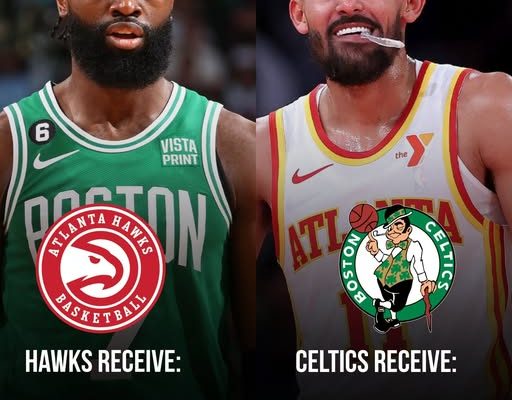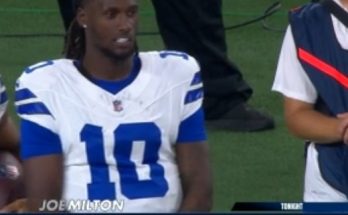The Boston Celtics have once again shaken the NBA landscape with a trade that is bound to reverberate across the Eastern Conference. In a move that will leave fans, analysts, and rivals alike scrambling to assess the implications, the Celtics have agreed to send All-Star forward Jaylen Brown to the Atlanta Hawks in exchange for dynamic point guard Trae Young. This blockbuster transaction is more than a simple swap of talent; it represents a seismic shift in Boston’s approach to building its roster, reimagining its offensive philosophy, and attempting to assert itself as the dominant force in a fiercely competitive conference. With this trade, the Celtics are signaling their willingness to take bold risks, sacrificing a cornerstone of their recent success for a new type of star power that could redefine their trajectory for years to come.
Jaylen Brown has been a pivotal figure for the Celtics since his early days in Boston, evolving from a promising rookie into a perennial All-Star and a cornerstone of the franchise’s championship aspirations. Known for his combination of athleticism, defensive prowess, and offensive versatility, Brown has been a player capable of taking over games and delivering in high-pressure situations. His growth alongside Jayson Tatum has cemented Boston as a perennial contender, and his departure represents the end of an era in which the Celtics relied heavily on two-way wings to carry their championship hopes. Brown’s ability to attack the rim, stretch the floor with his three-point shooting, and guard multiple positions made him a unique asset in Boston’s system, one that will be sorely missed by fans and teammates alike.
However, the Celtics’ acquisition of Trae Young offers a different type of star power, one that aligns with the modern NBA’s emphasis on pace, space, and explosive scoring. Young has emerged as one of the league’s most electrifying point guards, capable of orchestrating an offense with vision and creativity while simultaneously creating his own shot from virtually anywhere on the court. His deep shooting range, fearless drives to the basket, and ability to generate points for his teammates make him a transformative presence on any roster. By adding Young, Boston is signaling a shift away from a more balanced, wing-oriented approach to one centered on high-octane guard play, with an emphasis on floor spacing and relentless offensive pressure.
The trade also carries significant implications for Boston’s supporting cast and overall roster construction. With Young in the backcourt, Jayson Tatum will likely see his role evolve, benefiting from an elite facilitator who can command attention from opposing defenses and create opportunities for him to thrive. The Celtics’ perimeter-oriented wings, previously anchored by Brown’s two-way capabilities, may now need to adapt to a system that prioritizes pick-and-roll action, spacing, and tempo over traditional wing defense. Additionally, bench players who excel in secondary playmaking or off-ball movement will find themselves in a position to capitalize on Young’s court vision and passing acumen, potentially unlocking untapped offensive potential for the roster.
From a defensive standpoint, Boston will face new challenges without Brown patrolling the wing. Brown’s ability to guard multiple positions, contest shots, and protect the rim as a help defender has been integral to the Celtics’ defensive identity. Replacing his versatility will require a combination of strategic adjustments, the emergence of other defenders, and potentially supplemental moves in free agency or future trades. The Celtics’ front office and coaching staff will need to balance the trade-off between offensive explosiveness and defensive stability, ensuring that the team maintains the competitiveness and identity that has characterized Boston basketball for decades.
The Hawks, on the other hand, stand to gain a player who can immediately alter their competitive profile. Jaylen Brown brings championship experience, elite two-way ability, and a proven track record of delivering in high-stakes moments. Pairing Brown with Atlanta’s existing core, including talented young pieces and veteran contributors, could elevate the Hawks into serious contention in the Eastern Conference. Brown’s presence alleviates some of the pressure on the backcourt while giving Atlanta a versatile forward who can contribute across all facets of the game. For a team seeking to build sustainable success while remaining competitive in a loaded conference, acquiring Brown represents both a statement of intent and a significant upgrade in roster stability.
Financially and strategically, the trade also makes sense within the context of the modern NBA. Both players are All-Star-caliber talents with significant marketability and fan engagement potential, making the trade compelling from a business perspective. While the move involves risk for both franchises, particularly with respect to fit and defensive implications, it also provides an opportunity to reset narratives and energize fanbases. For Boston, Young offers the chance to reimagine their offensive identity and appeal to a broader audience with his highlight-reel scoring and playmaking. For Atlanta, adding Brown signals a commitment to championship contention and an investment in proven, two-way talent.
The timing of this trade further underscores its impact. Coming in the offseason, both teams have an opportunity to recalibrate their rosters, integrate new pieces, and establish chemistry before the grind of the regular season begins. Boston’s coaching staff will need to design schemes that maximize Young’s strengths while minimizing exposure defensively, potentially experimenting with small-ball lineups, innovative pick-and-roll sets, and high-tempo spacing. Meanwhile, the Hawks will likely seek to incorporate Brown into their system in a manner that preserves his offensive freedom while leveraging his defensive versatility to shore up team weaknesses. Both teams will face an intensive period of evaluation, adjustment, and strategic planning, with the eyes of the NBA world firmly fixed on their every move.
Public and media reaction to the trade has been intense, with analysts weighing in on the short-term and long-term ramifications. Supporters of the move praise Boston’s willingness to think outside the box and take risks in pursuit of an elite offensive star who can change the complexion of playoff matchups. Critics, however, caution that losing Brown may destabilize the team’s defensive identity and create a reliance on one of the league’s highest-usage guards, whose defensive liabilities are well-documented. In Atlanta, the narrative focuses on the acquisition of a proven two-way star who can lead a team in both scoring and defense, potentially transforming the Hawks into legitimate contenders in the East. The discussion is lively, nuanced, and emblematic of the way blockbuster trades can reshape not only rosters but entire conversations about league dynamics.
Looking ahead, the trade sets the stage for a season filled with intrigue, particularly in the Eastern Conference. Boston now has the potential to play at an unprecedented offensive pace, leveraging Young’s scoring ability and court vision to create mismatches, generate fast-break opportunities, and pressure defenses in new ways. Tatum’s scoring acumen, combined with Young’s playmaking, could make Boston one of the most difficult teams to defend in the league, provided they can mitigate defensive vulnerabilities and maintain balance. For Atlanta, Brown’s integration could solidify a roster capable of competing with the top contenders, offering versatility, scoring depth, and defensive stability that complements the Hawks’ existing core.
The trade also has broader implications for the league as a whole. Teams observing this transaction may rethink their own approaches to roster construction, weighing the value of two-way wings against high-volume point guards, and reassessing the balance between offense and defense in championship pursuits. The Boston-Atlanta swap serves as a case study in risk, reward, and the evolving philosophy of what it takes to build a contender in today’s NBA. Fans, media, and rival executives will be watching closely to see which team emerges as the winner in the months and years ahead.
Ultimately, this blockbuster trade underscores the ever-changing nature of the NBA landscape, where franchises are willing to make bold moves to position themselves for sustained success. By trading Jaylen Brown for Trae Young, the Boston Celtics have not only redefined their roster but also sparked a broader conversation about strategy, identity, and the future of the Eastern Conference. The Hawks, in turn, have acquired a star capable of elevating their competitive prospects and reshaping their team culture. As the dust settles, one thing is clear: this trade will be analyzed, debated, and remembered for years, representing a defining moment in the careers of both players and the fortunes of both franchises.
With the season on the horizon, all eyes will be on Boston and Atlanta to see how this daring move translates on the court. The Celtics’ gamble on Trae Young could pay off in spectacular fashion, creating a high-octane, record-breaking offensive juggernaut capable of challenging for a championship. Conversely, Atlanta’s acquisition of Jaylen Brown positions the Hawks as a resilient, balanced, and versatile contender, capable of matching up with any team in the East. Both teams are stepping into uncharted territory, and the NBA landscape will be forever changed as a result.
This trade will be remembered not just for the names involved but for what it represents: the courage to make a transformative decision, the willingness to take risks in pursuit of excellence, and the constant evolution of a league where stars, strategy, and bold vision intersect. As the Celtics and Hawks move forward, fans can expect drama, excitement, and unforgettable basketball moments that reflect the magnitude of this historic swap, solidifying the 2025 NBA offseason as one of the most memorable in recent history.
The ripple effects of this trade will extend beyond the two franchises, influencing playoff projections, award considerations, and the broader narrative of the Eastern Conference. Analysts will dissect every matchup, every adjustment, and every game in which Young or Brown takes the court, seeking to understand the full implications of a trade that reshapes not only the teams involved but the competitive dynamics of the entire league. In the end, whether this bold maneuver is remembered as a stroke of genius or a cautionary tale will depend on performance, chemistry, and the unpredictable nature of basketball itself.
The Boston Celtics’ decision to trade Jaylen Brown for Trae Young is a masterclass in ambition and strategic boldness. It challenges traditional notions of team-building, emphasizes the evolving priorities of modern NBA basketball, and creates a narrative rich with intrigue, risk, and opportunity. For fans of both teams, the 2025–26 season promises to be unforgettable, filled with highlight plays, strategic battles, and the kind of drama that only comes from high-stakes, high-impact moves of this magnitude.
This is more than a trade; it is a statement, a gamble, and a turning point. Boston and Atlanta have both staked their claims to the future, and the entire league will be watching to see who emerges as the true winner in a blockbuster exchange that redefines expectations, elevates star power, and reshapes the Eastern Conference in ways that will be felt for years to come.
The NBA has always been a league of bold decisions, and this trade exemplifies the calculated risks that franchises are willing to take in pursuit of glory. As Jaylen Brown dons a new uniform and Trae Young takes the helm in Boston, the stage is set for a dramatic, electrifying season that will captivate fans, challenge analysts, and leave an indelible mark on the annals of basketball history. The ripple effects of this trade will define narratives, influence strategies, and reshape the balance of power in the Eastern Conference, making this one of the most consequential moves of the modern era.
In the end, the trade of Jaylen Brown for Trae Young is a bold, ambitious, and transformative moment that captures the essence of the NBA: high stakes, high drama, and the constant pursuit of greatness. For Boston, Atlanta, and the league at large, the 2025–26 season begins with new possibilities, renewed rivalries, and the excitement that only a blockbuster trade of this magnitude can deliver. Fans, analysts, and players alike will be watching, debating, and marveling at the audacity and potential of this historic move, ensuring that it will be remembered as one of the defining moments of the decade in professional basketball.



